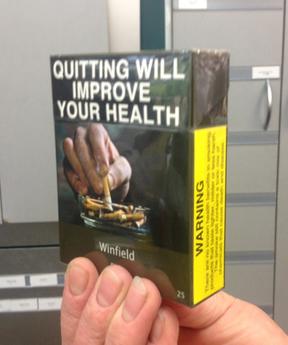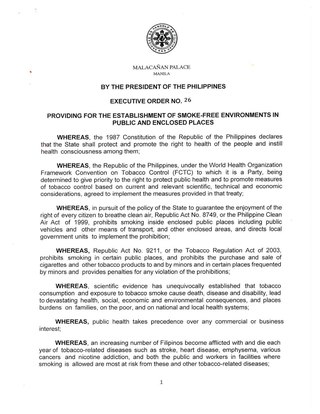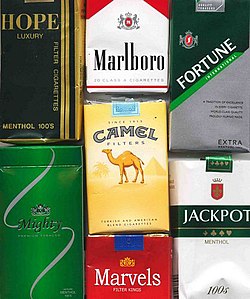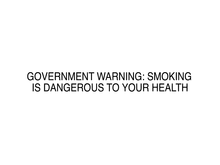
A cigarette is a narrow cylinder containing a combustible material, typically tobacco, that is rolled into thin paper for smoking. The cigarette is ignited at one end, causing it to smolder; the resulting smoke is orally inhaled via the opposite end. Cigarette smoking is the most common method of tobacco consumption. The term cigarette, as commonly used, refers to a tobacco cigarette, but the word is sometimes used to refer to other substances, such as a cannabis cigarette or an herbal cigarette. A cigarette is distinguished from a cigar by its usually smaller size, use of processed leaf, and paper wrapping, which is typically white. Most modern cigarettes are filtered, although this does not make the smoke inhaled from them contain fewer carcinogens and harmful chemicals.

Tobacco smoking is the practice of burning tobacco and ingesting the resulting smoke. The smoke may be inhaled, as is done with cigarettes, or simply released from the mouth, as is generally done with pipes and cigars. The practice is believed to have begun as early as 5000–3000 BC in Mesoamerica and South America. Tobacco was introduced to Eurasia in the late 17th century by European colonists, where it followed common trade routes. The practice encountered criticism from its first import into the Western world onwards but embedded itself in certain strata of a number of societies before becoming widespread upon the introduction of automated cigarette-rolling apparatus.Out of 8 million annual deaths, second hand smoke due to smoking is responsible for 1.3 million deaths worldwide as per WHO report.
Tobacco package warning messages are warning messages that appear on the packaging of cigarettes and other tobacco products concerning their health effects. They have been implemented in an effort to enhance the public's awareness of the harmful effects of smoking. In general, warnings used in different countries try to emphasize the same messages. Warnings for some countries are listed below. Such warnings have been required in tobacco advertising for many years, with the earliest mandatory warning labels implemented in the United States in 1966. Implementing tobacco warning labels has been strongly opposed by the tobacco industry, most notably in Australia, following the implementation of plain packaging laws.
Tobacco harm reduction (THR) is a public health strategy to lower the health risks to individuals and wider society associated with using tobacco products. It is an example of the concept of harm reduction, a strategy for dealing with the use of drugs. Tobacco smoking is widely acknowledged as a leading cause of illness and death, and reducing smoking is vital to public health.

Tobacco politics refers to the politics surrounding the use and distribution of tobacco.

Tobacco control is a field of international public health science, policy and practice dedicated to addressing tobacco use and thereby reducing the morbidity and mortality it causes. Since most cigarettes and cigars and hookahs contain/use tobacco, tobacco control also concerns these. E-cigarettes do not contain tobacco itself, but (often) do contain nicotine. Tobacco control is a priority area for the World Health Organization (WHO), through the Framework Convention on Tobacco Control. References to a tobacco control movement may have either positive or negative connotations, depending upon the commentator.

The Family Smoking Prevention and Tobacco Control Act, is a federal statute in the United States that was signed into law by President Barack Obama on June 22, 2009. The Act gives the Food and Drug Administration the power to regulate the tobacco industry. A signature element of the law imposes new warnings and labels on tobacco packaging and their advertisements, with the goal of discouraging minors and young adults from smoking. The Act also bans flavored cigarettes, places limits on the advertising of tobacco products to minors and requires tobacco companies to seek FDA approval for new tobacco products.

Tobacco has a long history in the United States.

The use of tobacco products in Egypt is widespread. It is estimated that approximately twenty percent of the population uses tobacco products daily. Cigarettes are the most common form of tobacco consumption in Egypt, with an estimated twenty billion cigarettes smoked annually in the country. After cigarettes, shisha water-pipes are the most common form of tobacco consumption.
Smoking in Ireland is banned fully in the general workplace, enclosed public places, restaurants, bars, education facilities, healthcare facilities and public transport. However, it is permitted in designated hotel rooms and there is no ban in residential care, prisons and in outdoor areas. Public opinion is in favour of the bans on smoking imposed in Ireland.

Smoking in Iceland is banned in restaurants, cafés, bars and night clubs as of June 2007. A large majority of Icelanders approve of the ban. At the time the ban went into effect, almost one in four Icelandic people were smokers.

Plain tobacco packaging, also known as generic, neutral, standardised or homogeneous packaging, is packaging of tobacco products, typically cigarettes, without any branding, including only the brand name in a mandated size, font and place on the pack, in addition to the health warnings and any other legally mandated information such as toxic constituents and tax-paid stamps. The appearance of all tobacco packs is standardised, including the colour of the pack.
Smoking in South Korea has decreased overall for both men and women in the past decades. However, a high prevalence of tobacco use is still observed, especially with the rise of novel tobacco products such as e-cigarettes and heat-not-burn tobacco products. There are socioeconomic inequalities in smoking prevalence according to gender, income, education, and occupational class. Advocates call for measures to reduce the smoking rates and address smoking inequalities using a combination of monitoring and tobacco control policies. These measures include significant price hikes, mandatory warning photos on cigarette packs, advertising bans, financial incentives, medical help for quitting, and complete smoking bans in public places.

Smoking in India is one of the oldest industries and provides employment to more than five million people directly and indirectly. India is the second-largest producer of tobacco in the world. Smoking has been known since at least 2000 BC when cannabis was smoked and is first mentioned in the Atharvaveda. Fumigation (dhupa) and fire offerings (homa) are prescribed in the Ayurveda for medical purposes and have been practiced for at least 3,000 years while smoking, dhumrapana has been practiced for at least 2,000 years. Tobacco was introduced to India in the 17th century. It later merged with existing practices of smoking.

Smoking in Costa Rica is still somewhat prevalent, and according to the Global Adult Tobacco Survey (GATS) in 2015, 8.9% of the population smoked tobacco. The number of people exposed to secondhand smoke indoors while at the workplace was 6.3% while 4.9% were exposed in their own home.

Executive Order No. 26, entitled Providing for the Establishment of Smoke-Free Environments in Public and Enclosed Places, was issued by Philippine President Rodrigo Duterte on May 16, 2017. This executive order invoked the Clean Air Act of 1999 and the Tobacco Regulation Act of 2003 to impose a nationwide ban on smoking in all public places in the Philippines. The ban replicates on a national level an existing ordinance in Davao City that Duterte created as mayor in 2002. The order took effect on July 23, 2017, 60 days after its publication in a newspaper.

As nicotine is highly addictive, marketing nicotine-containing products is regulated in most jurisdictions. Regulations include bans and regulation of certain types of advertising, and requirements for counter-advertising of facts generally not included in ads. Regulation is circumvented using less-regulated media, such as Facebook, less-regulated nicotine delivery products, such as e-cigarettes, and less-regulated ad types, such as industry ads which claim to discourage nicotine addiction but seem, according to independent studies, to promote teen nicotine use.
Smoking in Latvia is common, with a rate higher than the OECD average, and Latvian men are among the heaviest smokers in the European Union. One in four Latvians smoke, as compared to one in five in the rest of the European Union. While the overall smoking rate in Latvia has decreased in recent years, it is considered a significant factor in the country's significant health challenges, particularly with regard to preventable diseases such as heart disease, diabetes, and cancer.
Smoking in Australia is restricted in enclosed public places, workplaces, in areas of public transport and near underage events, except new laws in New South Wales that ban smoking within ten metres of children's play spaces.

The Vaporized Nicotine and Non-Nicotine Products Regulation Act, officially recorded as Republic Act No. 11900, is a law in the Philippines which aims to regulate the "importation, sale, packaging, distribution, use and communication of vaporized nicotine and non-nicotine products and novel tobacco products", such as electronic cigarettes and heated tobacco products. It lapsed into law on July 25, 2022. As a proposed measure, the law was known as the Vape Regulation Bill.



















